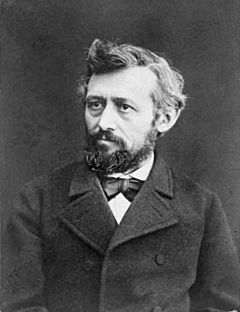Carl Culmann facts for kids
Quick facts for kids
Carl Culmann
|
|
|---|---|
 |
|
| Born | 10 July 1821 Bad Bergzabern, Germany
|
| Died | 9 December 1881 (aged 60) |
| Nationality | German |
| Scientific career | |
| Fields | Structural engineering |
Carl Culmann (July 10, 1821 – December 9, 1881) was a German structural engineer. He developed new ways to design strong and safe structures like bridges.
Carl was born in Bad Bergzabern, a town in what is now Germany. His father, who was a pastor, taught him at home when he was young. Later, Carl went to a military engineering school to prepare for a famous engineering college. However, he got very sick with typhoid fever. After he recovered, he attended the Karlsruhe Polytechnic School.
In 1841, Carl started working for the government in Bavaria. He was an apprentice engineer, which means he was learning on the job. His main task was to help design railroad bridges.
Studying Abroad and New Ideas
Carl continued to study mathematics. In 1847, he moved to Munich to improve his English. He planned to travel to the United Kingdom and the United States. From 1849 to 1851, he visited these countries. He studied how different truss bridges were designed. A truss is a framework, often made of triangles, that makes a structure very strong. During his travels, Carl also started to develop new ways to analyze these designs.
Teaching and Famous Work
In 1855, Carl Culmann became a professor at the Swiss Federal Institute of Technology in Zürich, Switzerland. He taught engineering sciences there until he passed away.
Carl was inspired by another engineer named Jean-Victor Poncelet. Carl became a pioneer in using graphical methods in engineering. This means he used drawings and diagrams to solve complex engineering problems. In 1865, he published his most important book, Die graphische Statik (which means Graphic Statics). This book showed engineers how to use his new drawing methods. A French version of his book was made in 1879.
Carl Culmann had a big impact on many engineers who came after him. Some of his famous students and followers included Maurice Koechlin, Otto Mohr, and Luigi Cremona. Carl Culmann died in Zürich, Switzerland, in 1881.
See also
 In Spanish: Karl Culmann para niños
In Spanish: Karl Culmann para niños
- Biomechanics
- Mechanostat
- Mohr's circle
- Truss

